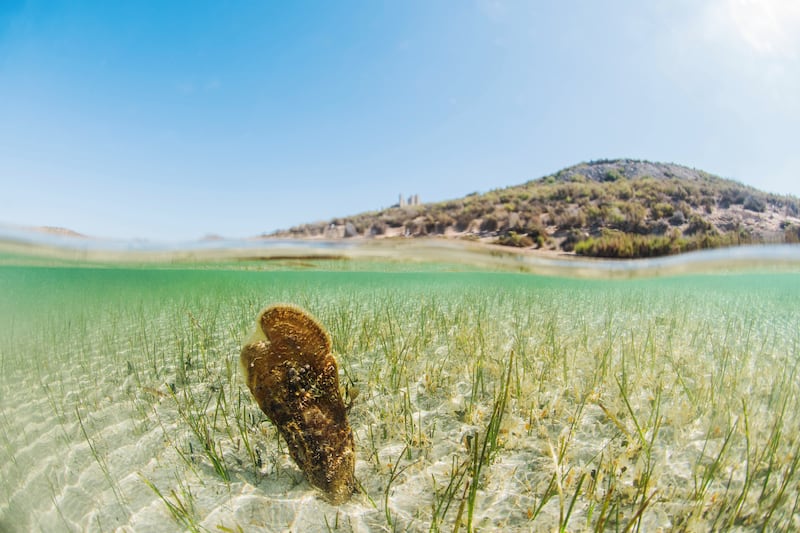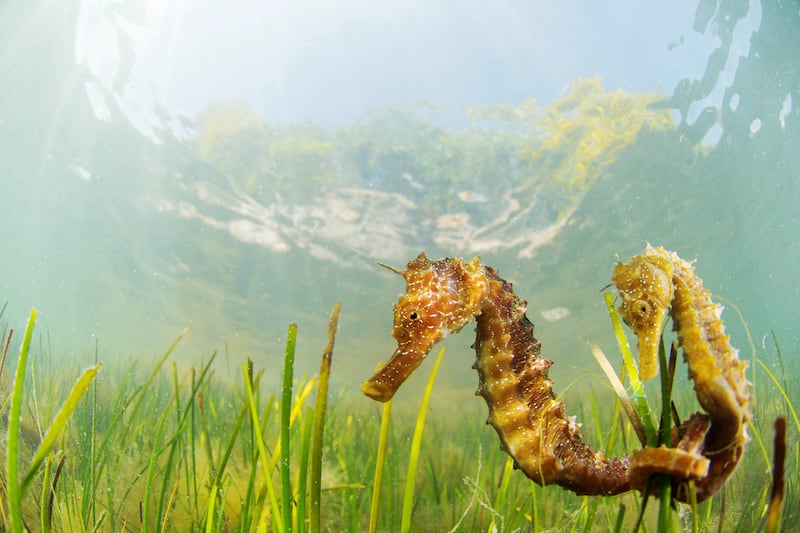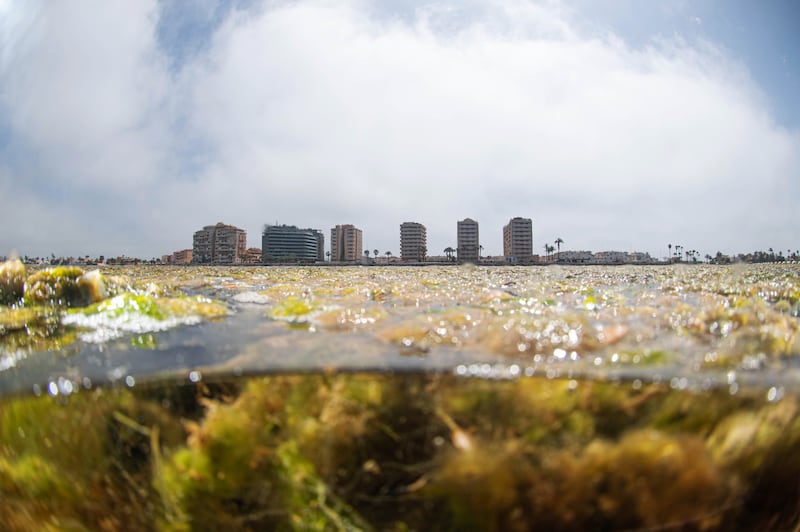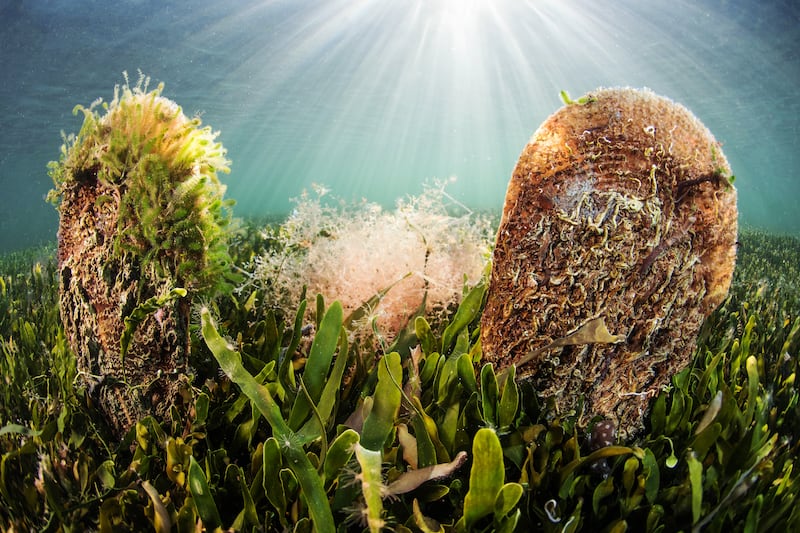“My heart breaks when I go swimming here these days and I don’t see a single sea horse,” Isabel Rubio, a veteran local environmental activist, tells us. We are standing by a beach overlooking the Mar Menor, Europe’s largest lagoon, in the Spanish region of Murcia.
Sea horses were abundant in the lagoon in Rubio’s childhood, bobbing through vast green meadows of seagrass. Since the 1970s, however, this exceptional rich marine ecosystem has been impoverished in complex ways. Sea horses, along with many of its characteristic species, have become rarities. And then, in the last seven years, the whole lagoon has suffered dramatic successive collapses. These are text book illustrations of how a degraded system can suddenly tip over towards catastrophe, and of how biodiversity loss and climate change are wickedly interlinked.
It is our jewel, the wonder of our coastline
Rubio is speaking to us on a field trip from a conference of the Society for Ecological Restoration Europe (SERE) in nearby Alicante. We are led by Francisca Giménez Casalduero, a professor of marine ecology, and an expert on the lagoon. She traces its vertiginous decline to agricultural intensification in the lagoon’s catchment. This view is highly controversial locally, but she argues compellingly that the lagoon can only be restored if the economic and political interests invested in unsustainable practices are faced down.

The Mar Menor covers 170 sq km, and is separated from the Mediterranean by La Manga, a very narrow band of land extending along 70km of coastline. The lagoon’s maximum depth is just seven metres, subjecting it to rapid changes in water temperature. Its hinterland, historically semi-arid, meant it used to receive minimal fresh water and nutrient run-off. Evaporation also made it much more saline than the sea, to which it was connected by few and, until the 1970s, very shallow channels. All these factors combined to produce highly distinctive communities of plants and animals.
It is designated as a Ramsar Wetland of International Importance, and as part of the EU Natura 2000 network. But as we know all too well in Ireland, such designations do not guarantee protection.
Most recently, the Mar Menor became the first ecosystem in Europe to be granted “rights of personhood”, a radical new legal concept that has produced remarkable results in New Zealand and India.
This move, launched by a local law professor, was supported by 640,000 signatures, and approved by the Spanish Senate last September. This means that any citizen can, in the name of the lagoon, sue anyone polluting it, hopefully making environmental law more enforceable.

As Isabel Rubio makes vividly clear, local people and visitors have appreciated and loved the Mar Menor for millennia – the Carthaginians settled nearby – both for its economic value – first fishing and salt production, then tourism – and also for its recreational, cultural and aesthetic qualities.
“It is our jewel, the wonder of our coastline,” she tells us. She has travelled the world, she says, and has never seen the sun rise more beautifully than over La Manga. She is the leader of the Pacto para el Mar Menor, a citizen’s movement formed to protect and restore the lagoon, when its degradation first received widespread public attention after massive algal blooms in 2015.
But the roots of its decline stretch much further back. When Spain opened up to tourism in the 1960s, the Mar Menor was promoted as a key destination. Intensive development on La Manga, including many marinas, led to one of its channels being greatly deepened and dredged, increasing interchanges with the sea one hundredfold.
This reduced the lagoon’s salinity, making it habitable for Mediterranean species – seaweeds, jellyfish and the very large fan mussel among them – which could not tolerate it previously. These new arrivals have had convoluted ecological impacts, related to the second major change in the region.
The once dry hinterland of the Campo Cartagena has been transformed in recent decades by intensive agricultural irrigation, much of it illegal. The lagoon’s freshwater intake soared, as ephemeral channels (ramblas), which used to flow only sporadically into the lagoon, became permanent streams. And this freshwater was now laced with nutrients, especially nitrates and phosphates, as fertiliser use surged.

The seaweeds and giant mussels, were very effective at consuming or filtering out the excessive nutrients that threatened to saturate the lagoon, though on the debit side the seaweeds were rapidly displacing the biodiverse native seagrass meadows.
And by hoovering up the nutrients, these species only masked the real situation. Excessive nutrient content – eutrophication – was not showing up in water tests, giving the false impression that all was well.
It was only when the nutrients exceeded the seaweed’s absorbent capacity that the degradation of the system became suddenly obvious. In 2015, an explosion of phytoplankton formed “rafts” kilometres long, cutting off light from the bottom. All the vegetation, plus the teeming animal life it sustained, like the fan mussels, an endangered species, disappeared from areas more than three metres deep. They became dead zones. The ecosystem had entered a crisis that many feared was irreversible.
TV news carried distressing images of millions of aquatic creatures, desperate to escape this toxic upsurge, hurling themselves in panic out on to the Mar Menor’s northern beaches
By late 2017, though, there appeared to be signs of recovery. Seaweed, at least, began to recolonise some of the bottom of the lagoon. There was a massive increase in tubeworms, which created micro-reefs, bringing back some diversity to the lower levels.
But in the summer of 2019, a new eutrophication crisis loomed, as nutrients continued to flow unchecked into the Mar Menor. That was bad enough, but then two extreme weather events coincided, tipping the lagoon towards ecological catastrophe.
That autumn, the Alicante/Murcia region was inundated by the heaviest rainfall on record. Floods from inland swept into the lagoon. Because this mass of freshwater was lighter than the saline lagoon, and was moving so fast, it skated across the surface, creating two distinct layers of water.

An exceptionally persistent wind then pushed much of the upper layer south, which inverted the layers in the north, dredging up anoxic water, and poisonous composites of sulphur and methane from the bottom. The upper zones, where many fish, crabs and prawns had survived years of eutrophication, suddenly became lethal.
What followed shocked the nation. TV news carried distressing images of millions of aquatic creatures, desperate to escape this toxic upsurge, hurling themselves in panic out on to the Mar Menor’s northern beaches. They suffocated in the air, while frantic locals attempted to return them to the water. Four tonnes of dead fish were collected in a single day, and smaller fish kills still occur.
Not only environmentalists are outraged. This is a terrible image for a tourist paradise. Property prices have plummeted. But while there is general agreement that the lagoon must be “saved”, there is fierce disagreement about what this means.
They wanted a swimming pool, not an ecosystem
Giménez claims that Murcia’s powerful autonomous government is too close to the farming lobby, and thinks solely in terms of cosmetic measures, of making the water translucent again, not in terms of restoring a historic native ecosystem. Farming interests, many corporate and foreign-owned, disclaim responsibility, and even some academics argue that the nutrients come mainly from urban waste, or even from the aquifer, not from the irrigation and fertilisers.
Visiting EU observers even suggested opening the lagoon right up to the sea. “They wanted a swimming pool, not an ecosystem,” says Rubio scathingly, and castigates the myopia of assuming the sea can absorb all our detritus. “Today, the Mar Menor can die,” she says. “Tomorrow, it can be the Mediterranean.”
Remarkably, however, the Spanish central government has now stepped in, on the grounds that restoring the lagoon is a matter of over-riding national importance. It has committed €500 million to the project over the next five years.
At the end our visit, Francisca Barraza, a senior civil servant, outlined the government plan to us very plausibly. It is strong on two of key elements Giménez has long argued for: enforcement of the law against illegal irrigation and fertiliser use, and at least as much focus on nature-based ecological restoration solutions as on hard engineering.
Will it work? “The measures they are taking are appropriate,” says Giménez, “but they are limited by the fact that the autonomous government controls our agriculture.”




